There was a majority of 7,091 votes in 2019 for the winner, Jim Shannon (DUP) over his Alliance challenger, Kellie Armstrong. The seat was created in 1983 and has always been unionist. Shannon has held it since 2010.
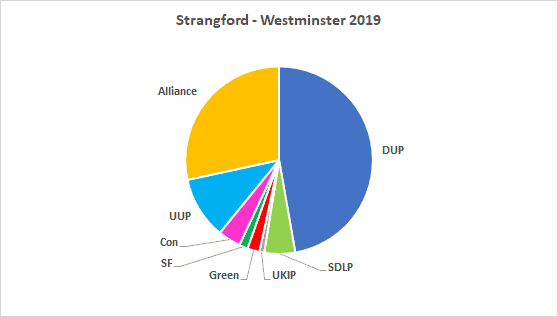
The changes made to the constituency boundaries last November were not substantial.
Candidates
Alexandra Braidner, Green
Gareth Burns, Independent
Garreth Falls, Independent
Michelle Guy, Alliance
Barry Hetherington, Conservative
Ron McDowell, TUV
Will Polland, SDLP
Jim Shannon, DUP
Richard Smart, UUP
Candidates’ electoral history
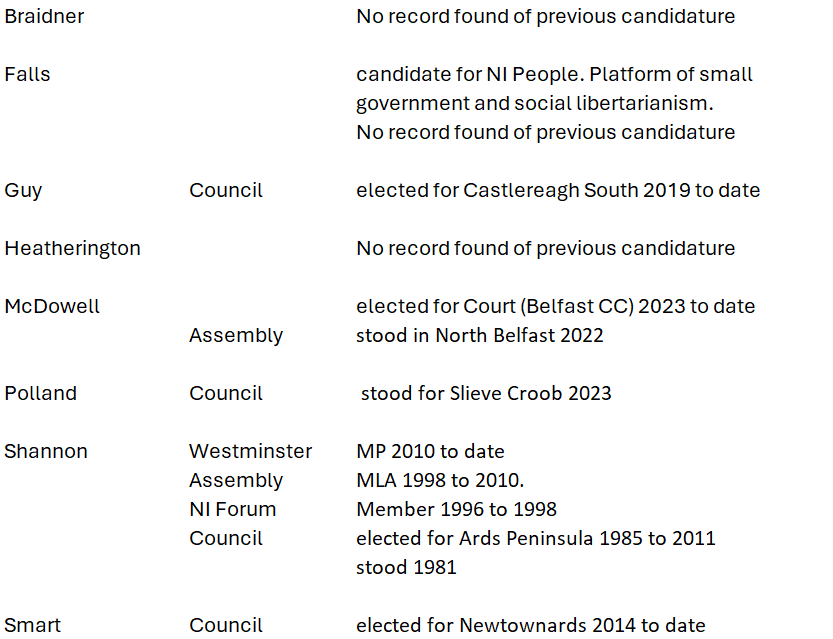



Vote shares by designation
There were no changes to the boundaries between 2010 and 2023.
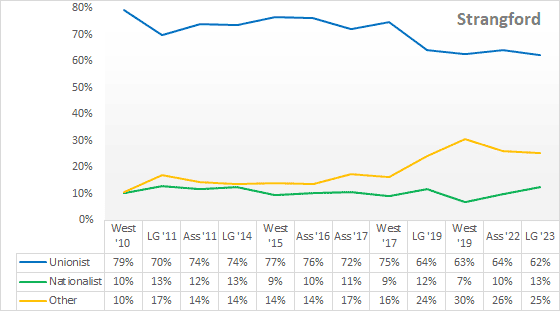

Please note that some Local Government electoral areas cross constituency boundaries which means that the LG figures have been estimated.
Over the period the trendline for unionists had fallen by 14% points and for nationalists by 1%. Others are up 15% points.
There appears to have been significant tactical voting by nationalists for Others at the last Westminster election.
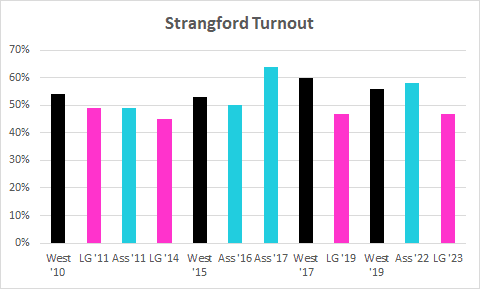

Strangford is a below average turnout constituency.
Vote share by party in Assembly and Local Government Elections
In the majority of constituencies there is an element of tactical voting in Westminster elections. Changes in the underlying strength of the principal parties within a constituency can best be understood by looking at their performance in other elections.
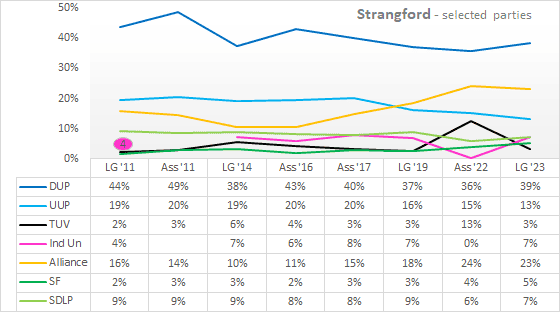

The Greens have stood at all but one election since 2010. Their highest share was 4% in 2014. They achieved 2% in all elections in the last five years.
The Conservatives got 2% in 2014, but normally get below 1%.
The bottom half of this chart is very crowded, so I reproduce it below at a larger scale.
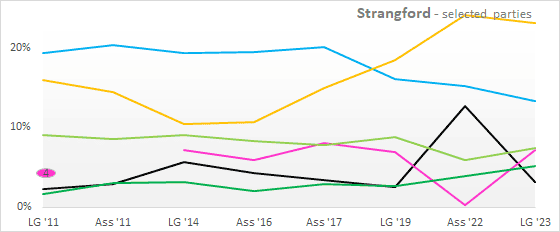

Amongst unionist parties only the TUV has an upward trendline, thanks to its peak in the last Assembly election it is up 3% points. The DUP is down 9% and the UUP down 5%.
Alliance is up 11%.
Sinn Féin is up 3% and the SDLP down 1%.
Vote share in Westminster elections
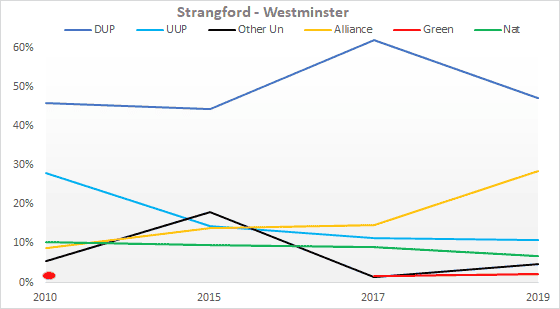



There appears to have been tactical voting going from the UUP to the DUP in the last two of these elections. Also, tactical voting from nationalists to Alliance in 2019.
The boundary changes
Calculating the effects of changes to constituency boundaries is not straightforward since there is no record of precisely how past votes for each party were distributed geographically. Necessarily this involves estimates and assumptions, and these may differ. For many years the UK media have all used the calculations provided by two academics, Rallings and Thrasher, to provide a notional result of how each constituency would have voted at the previous general election if the latest boundaries had been in force. For Northern Ireland their inputs are provided by Nicholas Whyte. These will be the base from which the media will report voting swings when constituency results are declared.
I used different assumptions for my own calculations of the notional vote which resulted in slightly different outcomes. In the following chart the Actual result in 2019 is compared with my estimate and the R&T estimate.
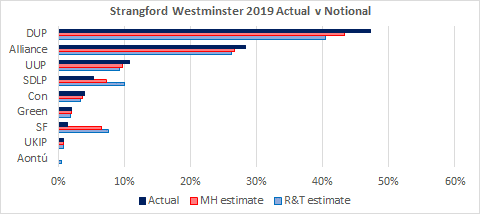

This gives different notional majorities for 2019.
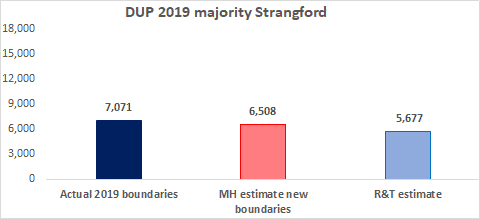

The R&T estimate gives the DUP less margin for safety.
Resources
In addition to money, the other key resource for an election campaign is the level of constituency work running up to the campaign, and the manpower available in the campaign itself. When it comes to constituency work MP’s and MLA’s have the advantage of an allowance for constituency offices and for a staffing. The amount of staffing money is specified, but MP’s and MLA’s can choose to allocate it to fewer higher-paid staff or a greater number of lower-paid staff.
When it comes to manpower for canvassing and leafleting a party’s elected representatives normally form the core of the group available. Party’s may also choose to bring in helpers from neighbouring constituencies which they have no hope of winning.
The Index Total for each party gives some idea of the relative strength of each party locally.
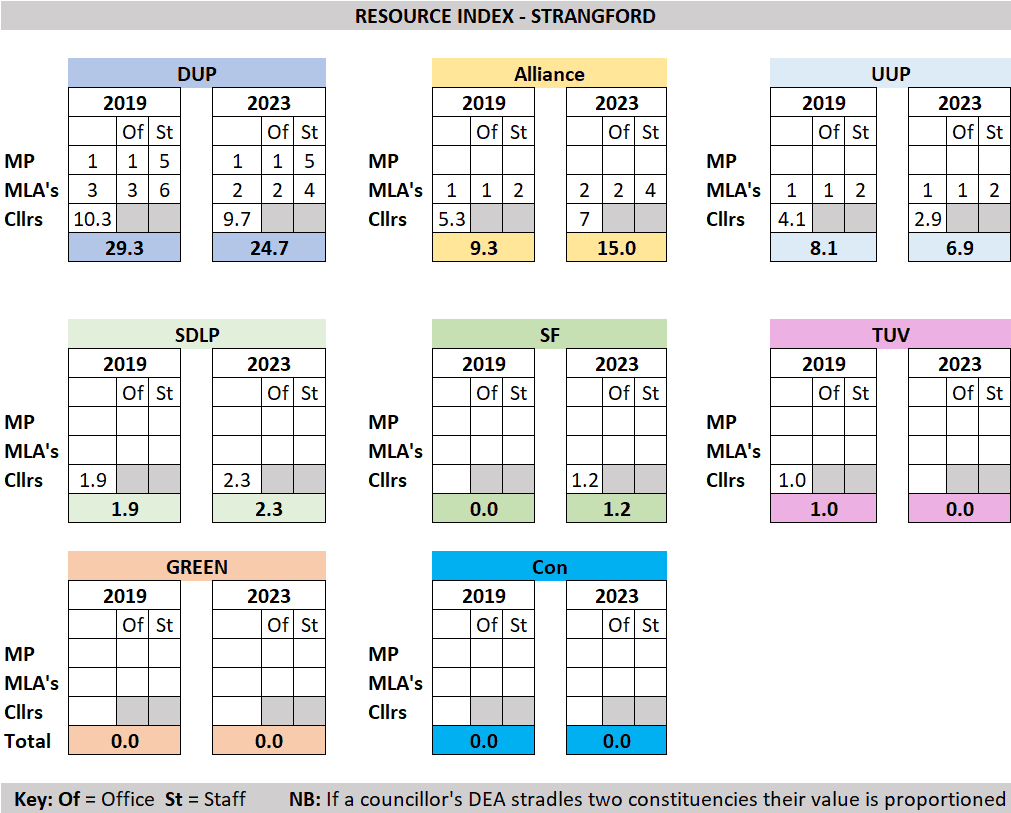

The two significant changes here are the increase in Alliance, with a second MLA and 2 more Councillors, and the drop in the DUP, with the loss of an MLA. This still leaves the DUP with a substantial advantage.
Factors possibly assisting the DUP
18.9% points ahead of Alliance at the last election.
No sign of decline in total unionist vote since 2019.
Lack of local TUV resources could limit its ability to take votes from the DUP.
Could TUV intervention assist DUP to squeeze 2 or 3% points more from the UUP vote?
Factors possibly harming the DUP
The TUV candidate could subtract up to 13% points share from DUP, at the TUV’s 2022 Assembly vote share. (Watch the LucidTalk polls. If the TUV share falls below 7%, the TUV can be expected to hurt the DUP proportionately less. If the TUV goes higher than 7% the damage may be proportionately more.)
Factors possibly assisting Alliance
Increased resources since 2019.
Boundary changes. Increased nationalist share of 8% to 11% potentially provides more votes to squeeze. In 2019 up to 40% of nationalist voters may have voted tactically. This could add 3 to 4% points to Alliance share.
Factors possibly harming Alliance
Boundary changes. Could subtract 1% or 2% from Alliance share.
Conclusion
Theoretically, if everything went wrong for the DUP (including a TUV share close to its 2022 level) and everything right for Alliance, the DUP could just lose. However, a much reduced DUP majority is far more likely.
Michael Hehir is a retired sales and marketing manager. He studied in Northern Ireland but now lives between England and Italy.
Discover more from Slugger O’Toole
Subscribe to get the latest posts to your email.



